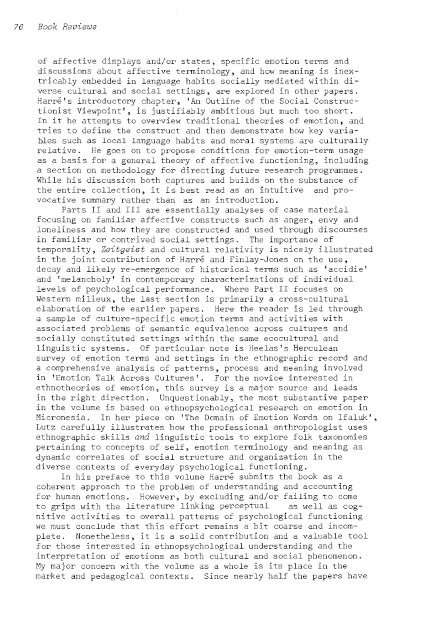CONTENTS NO.I - Institute of Social and Cultural Anthropology ...
CONTENTS NO.I - Institute of Social and Cultural Anthropology ...
CONTENTS NO.I - Institute of Social and Cultural Anthropology ...
You also want an ePaper? Increase the reach of your titles
YUMPU automatically turns print PDFs into web optimized ePapers that Google loves.
76 Book RevimJs<br />
<strong>of</strong> affective <strong>and</strong>/or states, emotion terms <strong>and</strong><br />
discussions about affective terminology, <strong>and</strong> how meaning is inextricably<br />
embedded in language habits<br />
mediated within diverse<br />
cultural <strong>and</strong> social settings, are in other papers.<br />
Harre's introductory<br />
, 'An Outline <strong>of</strong> the <strong>Social</strong> Constructionist<br />
Viewpoint', is<br />
ambitious but much too short.<br />
In it he attempts to overview traditional theories <strong>of</strong> emotion, <strong>and</strong><br />
tries to define the construct <strong>and</strong> then demonstrate how variables<br />
such as local language habits <strong>and</strong> moral systems are culturally<br />
relative. He goes on to propose conditions for emotion-term usage<br />
as a basis for a general theory <strong>of</strong> affective functioning,<br />
a section on methodology for<br />
future research programmes.<br />
While his discussion both captures <strong>and</strong> builds on the substance <strong>of</strong><br />
the entire collection, it is best read as an intuitive <strong>and</strong> provocative<br />
summary rather than as an introduction.<br />
Parts 11 <strong>and</strong> III are<br />
analyses <strong>of</strong> case material<br />
focusing on familiar affective constructs such as anger, envy <strong>and</strong><br />
loneliness <strong>and</strong> how they are constructed <strong>and</strong> used through discourses<br />
in familiar or contrived social settings. The importance <strong>of</strong><br />
temporality, Zeitgeist <strong>and</strong> cultural<br />
illustrated<br />
in the joint contribution <strong>of</strong> Harre <strong>and</strong><br />
<strong>and</strong> likely re-emergence <strong>of</strong> historical terms such as 'accidie'<br />
<strong>and</strong> !melancholy' in contemporary characterizations <strong>of</strong> individual<br />
levels <strong>of</strong> psychological<br />
Where Part 11 focuses on<br />
Western milieux, the last section is primarily a cross-cultural<br />
elaboration <strong>of</strong> the earlier papers. Here the reader is led through<br />
a sample <strong>of</strong> culture-specific emotion terms <strong>and</strong> activities with<br />
associated problems <strong>of</strong> semantic<br />
across cultures <strong>and</strong><br />
socially constituted within the same ecocultural <strong>and</strong><br />
systems.<br />
note is Heelas's Herculean<br />
survey <strong>of</strong> emotion terms<br />
in the<br />
record <strong>and</strong><br />
a<br />
patterns, process <strong>and</strong> meaning involved<br />
in 'Emotion Talk Across Cultures'. For the novice interested in<br />
ethnotheories <strong>of</strong> emotion, this survey is a or source <strong>and</strong> leads<br />
in the right direction. Unquestionably, the most substantive paper<br />
in the volume is based on<br />
research on emotion in<br />
Micronesia. In her on 'The Domain <strong>of</strong> Emotion Words on Ifaluk',<br />
Lutz carefully illustrates how the<br />
uses<br />
ethnographic skills <strong>and</strong> linguistic tools to explore folk taxonomies<br />
to concepts <strong>of</strong> self, emotion<br />
<strong>and</strong> meaning as<br />
correlates <strong>of</strong> social structure <strong>and</strong> organization in the<br />
diverse <strong>of</strong> psychological functioning.<br />
In<br />
to this volume Harre submits the book as a<br />
coherent to the problem <strong>of</strong> underst<strong>and</strong>ing <strong>and</strong> accounting<br />
for human emotions. However, by excluding <strong>and</strong>/or failing to come<br />
to with the literature linking perceptual as well as cognitive<br />
activities to overall patterns <strong>of</strong> psychological functioning<br />
we must conclude that this effort remains a bit coarse <strong>and</strong> incom-<br />
Nonetheless, it is a solid contribution <strong>and</strong> a valuable tool<br />
for those interested in ethnopsychological underst<strong>and</strong>ing <strong>and</strong> the<br />
<strong>of</strong> emotions as both cultural <strong>and</strong> social phenomenon.<br />
with the volume as a whole is its place in the<br />
contexts. Since nearly half the papers have

















